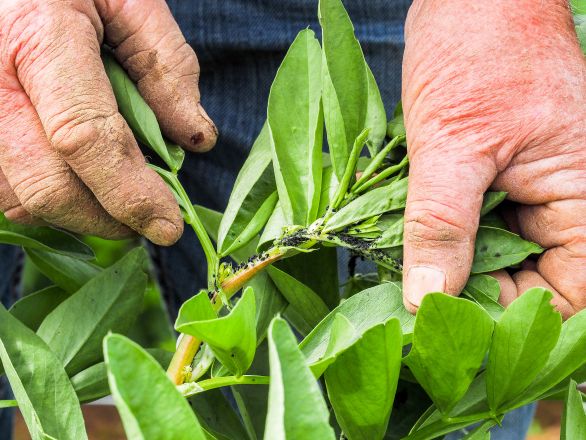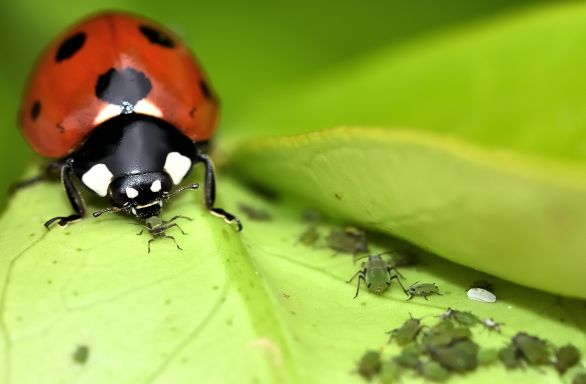 This spring, blue alfalfa aphid (Acyrthosiphon kondoi) infestations have re-emerged in some alfalfa fields, prompting concern among local growers. My office recently received an inquiry from a producer who was encountering early-season aphid pressure and seeking management guidance.
This spring, blue alfalfa aphid (Acyrthosiphon kondoi) infestations have re-emerged in some alfalfa fields, prompting concern among local growers. My office recently received an inquiry from a producer who was encountering early-season aphid pressure and seeking management guidance.
The blue alfalfa aphid is a large, blue-green aphid with long legs, antennae, cornicles, and a prominent cauda. It closely resembles the pea aphid (Acyrthosiphon pisum), but careful examination of the antennae can help distinguish between the two: the blue alfalfa aphid's antennae gradually darken toward the tip, while the pea aphid has distinctly banded segments.
Blue alfalfa aphids and pea aphids both prefer cooler temperatures, with optimal development occurring around 60°F. However, blue alfalfa aphids are more tolerant of cold conditions and tend to appear earlier in the growing season. While damaging numbers are most typical from spring into early summer in intermountain regions, this pest can also be found in fall and winter in some production areas. Both species may coexist in fields, however, blue alfalfa aphids typically concentrate at plant terminals, whereas pea aphids are more broadly distributed along stems and foliage.
Damage and impact
Feeding damage from blue alfalfa aphids results from both sap extraction and the injection of a plant toxin that can severely impact alfalfa growth. This toxin is more potent than that of the pea aphid and may cause stunting, yield reductions, and even plant death. Notably, the toxin can persist in stems and crowns following harvest, which may suppress regrowth and reduce yields in the subsequent cutting or even the next two cuttings.
Additionally, aphids excrete honeydew on alfalfa stems and leaves, on which a black sooty mold may grow, further reducing the quality and palatability of forage. Damage tends to be more severe in short alfalfa growth than in taller stands.
Monitoring and treatment thresholds
Growers are encouraged to begin monitoring alfalfa fields as soon as aphids are observed. Although economic thresholds differ between the two aphid species, if both are present, follow the blue alfalfa aphid guidelines. The following thresholds indicate when treatment may be economically justified for both blue alfalfa and pea aphids.
| Plant Height |
Pea Aphids |
Blue Alfalfa Aphids |
| Under 10 inches |
40–50/stem |
10–12/stem |
| 10–20 inches |
70–80/stem |
40–50/stem |
| Over 20 inches |
100+/stem |
40–50/stem |
Management strategies
An integrated pest management (IPM) approach that entails the use of resistant varieties, natural enemies, cultural practices, and chemical control options is recommended for managing blue alfalfa aphids. Follow IPM principles and use insecticides judiciously to preserve natural enemies.
Resistant varieties - Planting alfalfa varieties resistant to blue alfalfa aphids remains the most reliable long-term control measure. While prolonged cool temperatures can diminish the effectiveness of alfalfa’s resistance to aphids and lead to crop injury, resistance is generally fully expressed when temperatures approach 70°F. Visit the National Alfalfa and Forage Alliance at http://alfalfa.org for the latest recommendations on resistant varieties.
 Biological control - Several natural enemies provide meaningful suppression of aphid populations. Key predators include lady beetles (Hippodamia convergens and Coccinella septempunctata), green lacewings, big-eyed bugs (Geocoris spp.), damsel bugs (Nabis spp.), and Syrphid fly larvae. Parasitoids such as Aphidius smithi and Aphidius ervi are also important. The presence of golden-brown “mummified” aphids on upper leaves is evidence of parasitism. When parasitism is high, insecticide applications may not be necessary.
Biological control - Several natural enemies provide meaningful suppression of aphid populations. Key predators include lady beetles (Hippodamia convergens and Coccinella septempunctata), green lacewings, big-eyed bugs (Geocoris spp.), damsel bugs (Nabis spp.), and Syrphid fly larvae. Parasitoids such as Aphidius smithi and Aphidius ervi are also important. The presence of golden-brown “mummified” aphids on upper leaves is evidence of parasitism. When parasitism is high, insecticide applications may not be necessary.
Cultural control - Use border-strip cutting during harvest to conserve predator and parasitoid populations within the field. Cutting the field in strips and leaving some areas unharvested temporarily to support beneficial insects enhances biological control by providing refuge and breeding sites for natural enemies.
Chemical control - If aphid populations exceed treatment thresholds and biological control is inadequate, insecticide application may be justified. Consider the following options:
| Common Name [Mode of Action] |
Example Trade Name |
Rate/Acre |
REI (hrs) |
PHI (Days) |
Comments |
| Flupyradifurone [4D] |
Sivanto 200SL, Sivanto Prime |
7–14 fl oz |
12 |
7 |
Do not exceed 28.0 fl oz/acre/year total of either products. |
| Flonicamid* [29] |
Beleaf 50SG |
2.8 oz |
12 |
62 |
Allowed for commercial agricultural use only under NRS 586.600. |
| Dimethoate [1B] |
Dimethoate 2.67EC |
Label rate |
48 |
10–20 |
Avoid application when bees are present; see label for application limits per cutting and per year. |
| Methomyl [1A] |
Lannate SP |
0.5–1 lb |
48 |
7 |
Can kill natural enemies and is very toxic to bees. Don’t spray near blooming plants or weeds if bees are present and actively foraging. |
| Lambda-cyhalothrin [3A] |
Warrior II with Zeon |
1.28–1.92 fl oz |
24 |
1–7 |
Can disrupt natural enemies and is very toxic to bees. Don’t spray near blooming plants or weeds if bees are present and actively foraging. |
| Zeta-cypermethrin [3A] |
Mustang |
2.4–4.3 fl oz |
12 |
3–7 |
Can disrupt natural enemies and is very toxic to bees. Don’t spray near blooming plants or weeds if bees are present and actively foraging. |
Notes
- This isn’t a full list—products shown first are the most effective and least harmful to bees, natural enemies, and the environment. Always read the label instructions and consider timing, resistance, and water/air quality when choosing a product.
- Restricted entry interval (REI) is how long you must wait after spraying before entering the field without protective gear. Preharvest interval (PHI) is the number of days you must wait before harvesting. If REI is longer than PHI, follow the longer time before harvest.
- To avoid resistance, don’t use pesticides with the same mode-of-action group more than twice in a season. Rotate between products with different group numbers—for example, if you use a 1B product like an organophosphate, switch to a different group next time. You can find mode-of-action group numbers on the label or visit the Insecticide Resistance Action Committee (IRAC) at http://irac-online.org/ for more information.
- * Flonicamid has been categorized as a neonicotinoid insecticide, and according to NRS 586.600, any person seeking to apply neonicotinoid pesticides for commercial agricultural purposes must obtain a certificate of commercial agricultural use from the Nevada Department of Agriculture (NDA). Commercial agricultural purpose is explained under NRS 586.600 as the cultivation of plants or the use of farm and agricultural land to produce an agricultural product to be sold in commerce.
- Remember to look at the product label for “Restricted Use,” normally printed in big black letters. You will need to be certified by NDA to purchase and use Restricted-Use Pesticides (RUPs). Check out the RUPs on the EPA’s 2025 updated restricted use product list.
Reference
- Long RF, Goodell PB, Baldwin RA, Frate CA, Godfrey LD, Orloff SB, Canevari WM, Davis RM, Getts TJ, Grettenberger IM, Leinfelder-Miles M, Natwick ET, Putnam DH, Rethwish MD, Westerdahl BB, Wilson RG. Revised continuously. UC IPM Pest Management Guidelines: Alfalfa. UC ANR Publication 3430. Davis, CA.
- NDA. (n.d.). Plant industry - environmental compliance.
- Nevada Legislature (n.d.). NRS: Chapter 586 - Nevada Pesticides Act.


